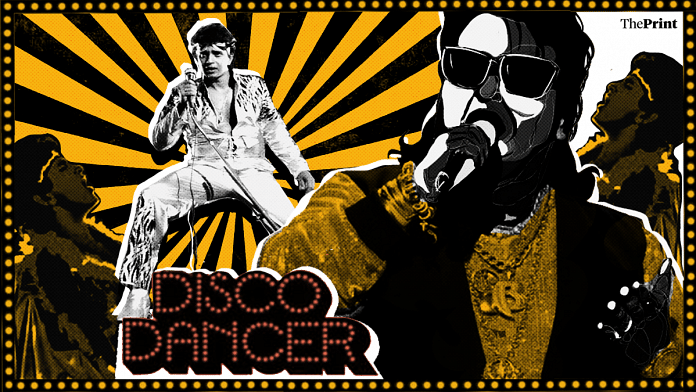New Delhi: When you hear the words “I am a disco dancer!”, you instantly hear disco tunes and picture a young Mithun Chakraborty, in tight silver pants and a half-open shirt, surrounded by disco lights, singing this to a crowd. And when these four words spark such vivid imagery, even 37 years later, you know that one film really did make a mark.
Disco Dancer (1982), directed by Babbar Subhash and starring Chakraborty, was easily the highlight of 1980s Bollywood. It was an era where storytelling was much less about the story than about how you told it — how much masala, music and mayhem a film had dictated how well it would be received. True to that, this rags-to-riches story of vendetta was more about disco than anything else.
And the person who gave it all the feels, the reason Disco Dancer was said to be one of the highest grossing films that decade, both in India and outside, is Bappi Lahiri. As the music director, Lahiri made the film what it was. Half the film is song and it is used not only as a plot device but actually makes disco music the primary character.
This past week saw his birth anniversary, and there is no more iconic film to celebrate him with.
Jimmy (Chakraborty) is a street musician, with a vendetta against the neighbourhood and its overlord that drove him and his mother out. He is discovered by a hot-shot talent manager (Om Puri) and becomes the biggest disco star in the country, replacing the son of the aforementioned overlord. As many obstacles are thrown his way in order to dethrone him, even putting his life in danger, Jimmy must find a way to keep the love for his music alive.
The film, full of metallic and blingy motifs, also borrows some specifics from other musical greats. The scene where Chakraborty is walking/dancing down the street, just about to be discovered, is reminiscent of John Travolta’s iconic walk in Saturday Night Fever (1977). A fight sequence between Jimmy and some goons, who for some reason insist on clicking their fingers throughout to taunt him, suddenly transports you to West Side Story (1966). The rags-to-riches drama is a favourite among all film industries, and keeps the protagonist’s motivation consistent.
The film starts with Na Goron Ki Na Kaalon Ki featuring Rajesh Khanna, is a song that features in bits through out. It is the only non-disco song in the entire film, but it underlines the basic theme of the plot — of music belonging to everyone. Next, comes the famous Auva Auva Koi Yahan Nache, sung by Usha Uthup and Bappi Lahiri. The song is pure disco — it has the bright lights, the tight white pants, and all the feverous hip thrusts.
The title track, I Am A Disco Dancer, is a punchy number with Chakraborty mesmerising the reel and real crowd with his suave, energetic moves. Jimmy Jimmy Jimmy Aaja, sung by Parvati Khan, is one of the most memorable songs of the film, which is not an easy feat. The song became so famous, it was covered by American singer M.I.A. and even featured in some films. And finally there’s Yaad Aa Raha Hai, sung by Lahiri, which is also seen as the most definitive disco track.
Disco Dancer did amazingly well at the box office, not only in India, but (surprisingly enough) in Russia. It drew millions to the theatre, and became a national obsession. Books were written, songs were covered and translated and Chakraborty’s moves were mimicked till years later. It remains, till today, the defining film in Chakraborty and Lahiri’s careers and in our disco-loving hearts.
Also read: Omkara to Sacred Games to Tanhaji: Saif Ali Khan is always on the edge of tomorrow




Truly ..an enigma …an electrifying era